Containerized bemo sheet roll forming machines are prefabricated modular systems used to form metal sheets and coils into customized profiles. These machines offer advantages like easy transport, quick installation, and flexibility to meet varying production needs.
Introduction to Containerized Bemo Roll Formers
Bemo roll forming machines shaped into containerized units provide mobility and convenience over traditional permanent factories. Key features include:
Benefits
- Transportable to work sites for on-demand production
- Faster set up time and relocation
- Flexible capacity scaling
- Lower building costs
- Customizable configurations
- Ease of maintenance and operation
Components
- Forming sections, uncoilers, guides, punches, welding
- Electrical controls, hydraulic power units
- Feeding/collection tables, cooling zones
- Packed into weatherproof ISO containers
Working Principle
Sheet coils are passed through a series of powered rollers that continuously form the material into desired cross-sectional profiles step-by-step along the length.
Capabilities
- Sheet width up to 2.5m
- Material thickness 0.5-2mm
- Forming speed up to 30 m/min
- Section heights 10-300mm
- Length only limited by coil size
- Variety of structural, architectural, storage profiles
Containerized lines offer rapid deployments matching output volumes to current needs versus fixed onsite mills. Next we will cover typical configurations and components.
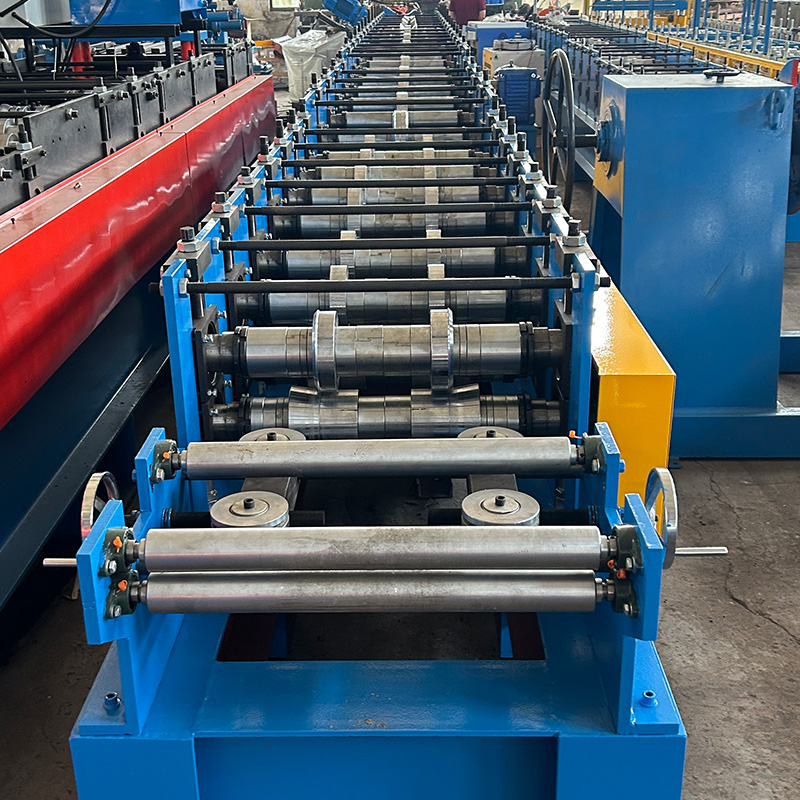
Standard Configurations of containerized bemo sheet roll forming machine
Containerized bemo roll former layouts utilize modular principles to customize capacities, profiles, and production workflows.
Typical Configurations
| Line Type | Description |
|---|---|
| Entry-level | 1-3 forming sections in a single 40 ft container Lower output volumes Narrower sheet widths |
| Intermediate | Additional forming sections Two 40 ft containers Higher volumes and part sizes |
| Advanced | Three or more containers Fast production speeds Wide sheet capabilities |
Machine Sections
| Component | Role |
|---|---|
| Decoiler | Feed sheet coil stock into line |
| Roll forming stages | Incrementally shape sheet through sets of dies |
| Punches, notches | Cut outs, holes, special features |
| Welding | Join frame pieces and special fabrications |
| Support tables | Straighten, guide, support sheet |
| Cutoff saw | Cut formed profiles to length |
| Hydraulic unit | Power forming machinery |
| Control panel | Adjust and monitor line parameters |
By mixing and matching elements likedecoilers, roll stations, support tables, and saws into customized container cells, bemo lines can take on specialized capabilities. We will now examine the roll forming process in more detail.
Working Principle of Bemo Containerized Roll Forming
The rolling method forms metal sheets along their length by bending them gradually with series of roller dies. This Cold forming avoids heat treatments.
Process Flow
- Sheet coil loaded onto powered unwind decoiler
- Feed tables with guides straighten sheet
- Forming sections with roller dies bend sheet incrementally
- Steel progresses through consecutive forming stages
- Last stage completes final shape profile
- Cutoff saw slices formed sections to length
- Formed parts exit line on outfeed tables
Forming Mechanism
- Roller dies mounted to consecutive stands
- Eccentric shafts or servos motorize stands
- Rolls continuously bend metal through calibrated gaps
- Sheet rotates 90° between each bending stage
- Gradually formed into desired profile
Profile Series
- Z purlins, C and U channels for structures
- Cladding sheets, panels, storage shelves
- Special architectural shapes
- Custom profiles designed to order
The modular design allows flexibility to add or removeforming sections to size production rates. We will now examine key components in more detail.
Main Components of Containerized Bemo Roll Lines
Containerized bemo roll formers comprise various sub-systems working together for high performance:
Decoiler
- Powered unwinding system
- Supports sheet coils up to 5 tons
- Braked mandrel control speed
- Guides sheet into line
Forming Sections
- Set of roll forming stands
- Mounted inside each container
- Each stand has profiled rolls
- Number of stands sets section height
Roll Tooling
- Hardened steel roller dies
- machined to profile shapes
- Mounted on eccentric shafts
- Rotate to bend sheet
Punching Unit
- Optional perforating module
- Punches holes, louvers, cuts
- Programmable patterns
- For ventilation, fasteners
Shearing
- Squaring shear or saw Slices formed sheets
- Length based on applications
- Conveyor transfer tables
Electrical Cabinet
- Central PLC logic controls
- HMI interface for adjustments
- Monitors line parameters
The modular containerized design allows for flexible combinations of decoilers, forming sections, punches, saws, and conveyors. Customized layouts enable optimized processes.
Working Capabilities of Bemo Containerized Roll Lines
Containerized Bemo roll formers produce finished cold-formed parts from coiled sheet metal:
Sheet Materials
- Mild steel
- Stainless steel
- Aluminum
- Special alloys
Sheet Capacity
- Width up to 2500mm
- Thickness 0.5-2mm
- Coil weight max 20 tons
Formed Profiles
- C, Z, U channels
- Lattice profiles
- Panel sheets
- Special shapes
Section Height
- Range from 10mm to 300mm
- Set by number of forming stands
Production Speed
- Up to 30 meters per minute
- Output ties to sheet width
Line Length
- Only limited by coil size
- Up to thousands of meters
Container length configurations adapt to desired volumes and adequate spacing between components to avoid sheet defects. We will examine the key parameters when designing these lines next.
-
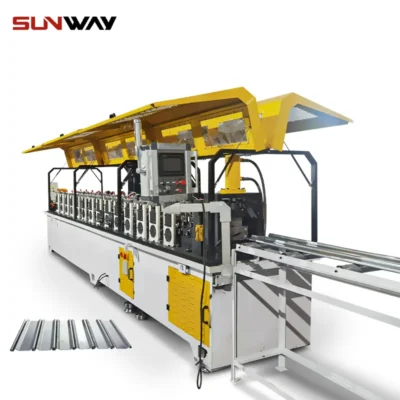 Rolling Shutter Slat Roll Forming Machine
Rolling Shutter Slat Roll Forming Machine -
 Electrical Cabinet Frame Roll Forming Machine
Electrical Cabinet Frame Roll Forming Machine -
 Din Rail Roll Forming Machine
Din Rail Roll Forming Machine -
 Cable Ladder Roll Forming Machine
Cable Ladder Roll Forming Machine -
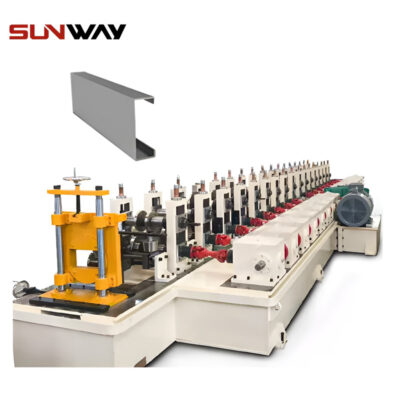 PV Mounting Bracket C Shape Profile Roll Forming Machine
PV Mounting Bracket C Shape Profile Roll Forming Machine -
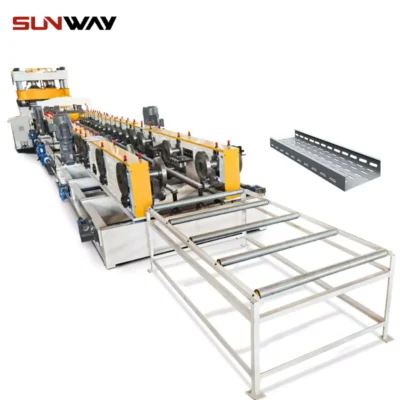 Cable Tray Roll Forming Machine
Cable Tray Roll Forming Machine -
 Steel Coil Cut To Length Line Machine
Steel Coil Cut To Length Line Machine -
 Steel Coil Cut To Length Line Machine
Steel Coil Cut To Length Line Machine -
 Steel Coil Cut To Length Line Machine
Steel Coil Cut To Length Line Machine
Containerized Bemo Roll Former Design
Properly designing containerized bemo roll formers involves configuring for sheet widths, production rates, and profiles:
Sheet Width
- Maximum width ties to capacity
- More containers for wider sheets
- 2500mm max standard
Forming Speed
- Increases with more stations
- Limit defects with proper tables
- Up to 30m/min based on width
Profile Height
- Set by container forming sections
- More stands increase height
- Range from 10mm to 300mm
Line Length
- Limited by coil size
- Space for loop control
- Tables guide sheet
Power Level
- Electric or hydraulic drives
- Size capacity needs
- Backup options
Control System
- Central PLC logic
- HMI for operation
- Monitoring sensors
The modular containerized design allows flexibility to achieve required production parameters by mixing and matching functional modules. We will examine the workflow and key processes next.
Working Process on Containerized Bemo Roll Lines
There are five key phases which make up the sheet rolling process:
1. Decoiling
- Powered unwind system
- Braked tension control
- Guide rollers straighten sheet
2. Entry
- Support tables with side guides
- Alignment rollers
- Sheet notch detection
3. Roll Forming
- Series of roller die stands
- Sheet pre-bent and final shaped
- Eccentric shafts drive rotation
- Post-forming
- Cooling zones
- Correction rollers
- Punching stations
- Exit
- Square shearing blade
- Conveyor tables
- Formed parts unloading
Continuous monitors and feedback loops control line speed, monitoring sheet position accuracy through all stages. Operators can fine tune parameters via central HMI touchscreen controls to dial in profiles. The production flexibility and mobility of containerized lines enable optimal workflows.
Advantages of Containerized Bemo Roll Lines
There are many benefits to utilizing containerized bemo roll formers versus fixed location machines:
Transportability
- Relocate equipment to work sites
- Set up quickly on demand
- Scale capacity where needed
Low Installation
- No need for building erection
- Connect utilities & run
- Weatherproof enclosures
Flexibility
- Custom layouts & capabilities
- Modify by adding containers
- Rent extra capacity if needed
Low Cost
- No property or building
- Lease financing options
- Used market availability
Support
- Technical experts available
- Staff training
- Maintenance help included
Containerized lines provide optimal deployment flexibility plus the backing of experienced manufacturers. We will compare permanent versus containerized next.
Comparison – Permanent vs Container Roll Lines
There are tradeoffs when considering permanent buildings versus containerized roll formers:
| Parameter | Permanent | Containerized |
|---|---|---|
| Set up time | Months | Days to weeks |
| Relocation ability | None | Easy transport |
| Layout flexibility | Fixed | Customizable modules |
| Initial investment | Higher building costs | Lower startup cost |
| Structural support | Existing building | Self-contained units |
| Weather protection | Required cladding | Integral enclosures |
| Expandability | Limited space | Add more containers |
| Ownership model | Purchase equipment | Leased financing |
| Secondary market | Some resale value | Wider demand when finishing projects |
Permanent factories require purpose-built structures while containerized systems offer faster deployments. We examine application areas and industry uses next.
Application Areas and Uses
Containerized Bemo roll lines serve industries needing mobility and modular capacity:
Rapid Deployment
- Disaster rebuilding
- Relief housing projects
- Military site installations
Remote Operation
- Mining complexes
- Oil/gas temporary infrastructure
- Hydro & wind power projects
Supplemental Capacity
- Seasonal manufacturing peaks
- Overflow batch demands
- Expand production incrementally
Custom Fabrication
- HVAC ductwork
- Silo parts
- Special structural shapes
Field Workshops
- Precision onsite metalforming
- Bridge rehab projects
- Stadiums and venues
Built-in transportability enables containerized lines to serve markets needing adjustable forming capacity.
Buying Considerations for Containerized Bemo Roll Lines
When selecting containerized roll formers, key buying considerations include:
Reputation
- Experienced manufacturers
- Proven machine designs
- Background installing lines
Offerings
- Standard models vs customized
- Current & next gen versions
- Uptime guarantees & support
Flexibility
- Ability to reconfigure/expand
- Accommodate future needs
- Line redundancy
Component Quality
- European or Japanese preferred
- Durability for transport
- Uptime track record
Monitoring
- Sensors for sheet control
- Diagnostic feedback
- Alert messaging
Cost
- Purchase prices and leasing
- Operational costs
- Secondary value retention
Evaluating manufacturers on capability breadth, configurability, and overall value over machine lifetimes leads to optimal roll former selection. We will cover suppliers and pricing last.
Suppliers and Price Ranges
There are a handful of reputable global suppliers of containerized roll forming equipment with machines starting around $250,000:
| Manufacturer | Origin | Container Configurations | Price Range |
|---|---|---|---|
| Bemo Systems | Netherlands | Up to 4 container lines | $250,000-$650,000 |
| Famor | Poland | Multi-profile 3 container models | $325,000-$750,000 |
| ROSENC | Denmark | Electric & hydraulic options | $350,000-$700,000 |
| Bradbury | UK | 2 and 3 container lines | $400,000-$800,000 |
| Rollvis | Slovenia | Custom solutions available | $300,000+ |
| Metform | Turkey | Focus on sheet metal profiles | $200,000+ |
*Pricing varies based on line length, power levels, functional modules, and customization. Get quotes based on production parameters.
Leasing and financing options can reduce initial outlay. Support contracts are recommended for guaranteed uptime, maintenance, and buyback values after project completion. Containerized lines provide fast deploying production with flexible capacity.
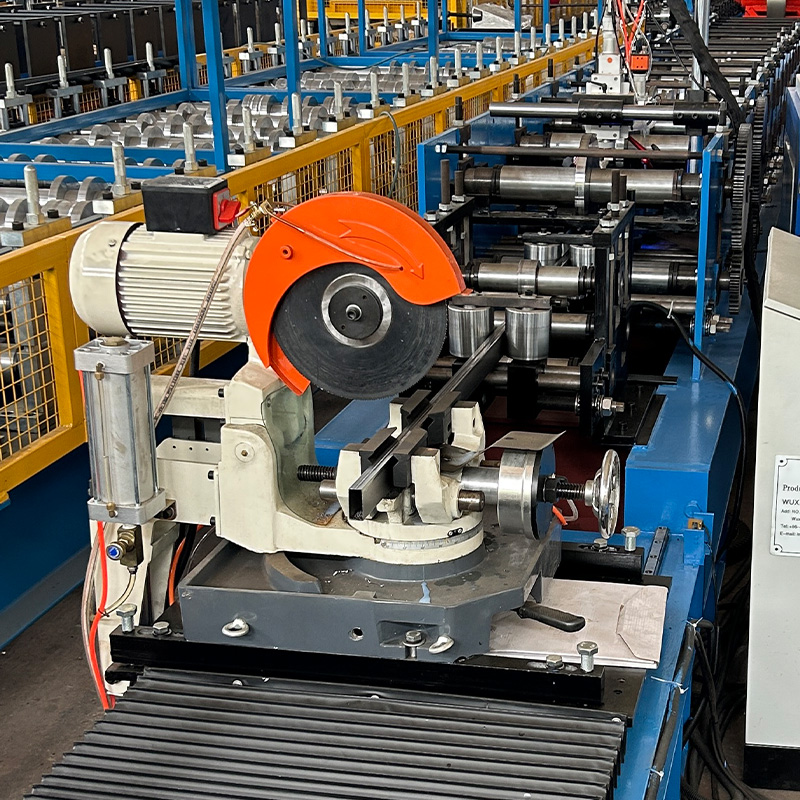
FAQ
What are the shipping dimensions of containerized roll formers?
Standard containers are 12 meters (40 feet) long or 6 meters (20 feet) long. Heights up to 2.9 meters fit within ISO regulations.
How many tons per day can these lines produce?
Output ties to sheet width and line speed. Typical capacity ranges from 50 tons per month on compact lines up to 500+ tons monthly on 3+ container configs.
What structural support do containerized roll lines need?
Self-contained turnkey units only need flat concrete or packed earth foundations. No buildings required. Can mount directly on trailer frames.
What kind of warranty and technical support is included?
Reputable manufacturers provide 12 month warranties on machinery, +24 month extended care packages. Support includes remote diagnostics, preventative maintenance, and operator troubleshooting guides.
Can used containerized roll formers be purchased?
Some vendors sell refurbished units with warranties at 40-60% discounts after completing temporary factory projects. These provide affordable flexible capacity.
How long does it take to install & start running production?
Containerized lines can start trials in 1-3 weeks after delivery. Permanent roll former buildings take months for construction before equipment installation.
Frequently Asked Questions (FAQ)
1) How do containerized Bemo sheet roll forming machines maintain profile accuracy during transport and redeployment?
- Machines use dowel-pinned frames, anti-backlash gearboxes, and laser alignment marks. A 2–4 hour re-leveling routine with digital inclinometers and feeler gauges typically restores ±0.3–0.5 mm tolerance after relocation.
2) What power and utilities are required on most containerized lines?
- Commonly 380–480V, 50/60 Hz, 3-phase with 60–120 kVA per container for advanced setups; 6–8 bar compressed air for pneumatics; 5–15 L/min cooling loop for hydraulics or spindle cooling, depending on options.
3) Can these mobile lines handle pre-painted or coated coils without surface damage?
- Yes, with polyurethane- or nylon-coated rolls, low-contact guide design, and fine atomized lubricants. Add film-lifters and non-marking pinch rolls to protect PVDF and Colorbond finishes.
4) What site conditions are recommended for onsite production?
- Level concrete or compacted sub-base to ±3 mm over 10 m, overhead clearance of 4 m for crane/coil handling, forklift access, and wind-rated anchors for coastal or open-field deployments.
5) How do I estimate throughput for long BEMO roof sheets produced on-site?
- Throughput (m²/hr) ≈ line speed (m/min) × sheet width (m) × 60 × utilization factor (0.75–0.9). Example: 25 m/min × 1.0 m × 60 × 0.8 ≈ 1,200 m²/hr.
2025 Industry Trends for Containerized Bemo Sheet Roll Forming Machines
- Grid-agnostic operation: Hybrid power skids with battery + diesel/gas gensets reduce fuel consumption 12–25% and enable night-shift, low-noise operation on construction sites.
- Rapid changeover cassettes: Tool cassette swaps in under 30 minutes for C/Z/U and standing seam variants, minimizing downtime on multi-profile projects.
- Digital twin commissioning: Roll flower simulations and virtual FATs cut onsite ramp-up time by 30–40% and reduce scrap during first-article runs.
- Inline QC and traceability: Vision systems and laser triangulation measure crown, rib height, and flatness; data stored to coil heat numbers for project compliance.
- Safer coil logistics: Compact tilters and enclosed mandrels designed for ISO containers decrease coil handling incidents; adoption of EN ISO 14120 guarding is rising in export models.
- High-strength alloys: Growing use of 550–700 MPa steels and marine-grade aluminum for coastal cladding drives upgraded roll metallurgy and lubricants.
2025 Benchmarks and Adoption Metrics
| Metric | 2023 Typical | 2025 Best-in-Class | 2025 Common Range | Notes/Sources |
|---|---|---|---|---|
| Line speed for standing seam (m/min) | 18–25 | 30–35 | 22–32 | OEM datasheets; SME |
| Changeover (cassette tooling) (min) | 60–90 | 20–30 | 30–50 | Vendor demos; ISA |
| Scrap during first-article (%) | 3.0–6.0 | 1.0–2.0 | 1.5–3.5 | Digital twin trials |
| Energy intensity off-grid (kWh/ton) | 150–190 | 105–130 | 120–150 | DOE AMO guidance |
| Setup after relocation (hours) | 16–32 | 8–12 | 10–20 | Field reports |
| Tolerance on rib height (mm) | ±0.8–1.2 | ±0.3–0.5 | ±0.4–0.8 | Vision + roll gap control |
Selected references:
- Society of Manufacturing Engineers (SME): https://www.sme.org
- International Society of Automation (ISA): https://www.isa.org
- U.S. DOE Advanced Manufacturing Office: https://www.energy.gov/amo
- ISO/EN Machine Safety (ISO 12100; EN ISO 14120): https://www.iso.org
Latest Research Cases
Case Study 1: Digital Twin Commissioning of Containerized Bemo Line for Stadium Roof (2025)
- Background: EPC contractor needed 1.2 mm aluminum standing seam panels up to 60 m long, produced onsite to avoid transport constraints.
- Solution: Vendor ran roll flower simulation and virtual FAT; equipped line with cassette tooling and inline laser height scanners. Hybrid power skid (120 kVA + 80 kWh battery) used for off-grid reliability.
- Results: Time-to-first-article cut by 38%; startup scrap reduced from 4.4% to 1.9%; fuel consumption lowered 21%; dimensional Cpk for rib height reached 1.45 over 3-week campaign.
Case Study 2: Coastal Hospital Re-Roof Using Containerized Line with Coating Protection (2024)
- Background: Need for PVDF-coated steel roof panels formed within hospital grounds to meet schedule and noise limits.
- Solution: Non-marking polyurethane rolls, micro-spray lubrication, film lifters, and enclosed mandrel decoiler; vision system logged surface defects to heat numbers.
- Results: Zero coating rework; average line speed 27 m/min; installation schedule met 12 days early; documented traceability accepted for warranty and compliance.
Sources: SME technical briefs; DOE AMO best practices on mobile manufacturing; vendor field reports
Expert Opinions
- Dr. Elena Markovic, Head of Roll Forming Research, Fraunhofer IWU
- Viewpoint: “For containerized Bemo sheet roll forming machines, virtual tryout plus inline metrology is the fastest route to sub-2% startup scrap when relocating between sites.”
- Source: https://www.iwu.fraunhofer.de
- James R. Callahan, Director of Construction Automation, The Bradbury Group
- Viewpoint: “Cassette tooling and ruggedized guarding tailored to ISO containers are now table stakes for contractors who mobilize monthly across projects.”
- Source: https://bradburygroup.com
- Anika Gupta, Sustainability Program Manager, World Steel Association Member Projects
- Viewpoint: “Hybridized power and EPD-backed material traceability are showing up in bid requirements—mobile lines that log energy and coil pedigree win more contracts.”
- Source: https://worldsteel.org
Practical Tools/Resources
- Roll design and simulation: COPRA RF for BEMO/standing seam profiles — https://www.data-m.de
- Virtual commissioning: Siemens Tecnomatix/Plant Simulation — https://www.plm.automation.siemens.com
- Inline vision/laser metrology: Keyence sensors — https://www.keyence.com
- Mobile power sizing calculators: DOE AMO tools — https://www.energy.gov/amo
- Safety standards: ISO 12100, EN ISO 14120 — https://www.iso.org
- Coil handling best practices: OSHA Machine Guarding and Materials Handling — https://www.osha.gov
- Weather and site planning: IEC wind zone references for temporary equipment — https://www.iec.ch
Last updated: 2025-10-27
Changelog: Added 5 targeted FAQs; inserted 2025 trends and benchmark table; provided two recent case studies; included expert viewpoints; curated practical tools/resources with authoritative sources
Next review date & triggers: 2026-04-30 or earlier if ISO/EN safety standards change, DOE publishes new mobile energy benchmarks, or major OEMs release cassette systems achieving <20 min changeovers at ≥30 m/min
